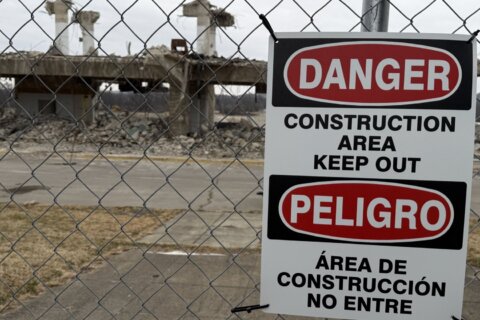This video is no longer available.
Roughly two and a half weeks after another collapse of D.C.’s 911 system — this time coinciding with the death of a baby whose parents struggled to get an ambulance to their apartment — city leaders are finally saying more about the problems they’ve been dealing with.
The city offered a full timeline Monday morning of what happened that day dispatching help to an apartment building next to the National Zoo — and acknowledged that similar problems have been plaguing the Office of Unified Communications, which handles 911 dispatching, for several months.
In fact, there have been 18 different incidents involving at least partial failure of computer-aided dispatching since December. There have been six such incidents since May 21, including Aug. 2, when an information technology worker messed up and pushed through a change that impacted all computers involved in dispatching, the city says.
Not all the breakdowns have impacted the entire dispatching system — sometimes it’s as few as two or three computers — but eight of those 18 crashes have had a much broader impact. That includes Aug. 2, when the result was two hours of black screens for dispatchers trying to coordinate emergency responses.
Those dispatchers then had to rely on pen and paper to organize details and hand deliver them to another dispatcher across the room working for the appropriate agency. It’s something they train for on a quarterly basis, with the most recent training for such a situation happening back in June.
But Heather McGaffin, who oversees the OUC, said things were still chaotic that afternoon when everything broke down.
“Switching from automated to manual, those are things that we’re certainly going to improve upon going forward,” she said after meeting with reporters. “We rely really heavily on technology, just like FEMS and MPD rely really heavily on technology, and so those are things that we just have to practice more, and we’re committed to doing in the future as part of first responders leadership.”
City leaders blame technology
While that explains one incident, city leaders say the biggest impediment to reliable 911 dispatching service has been the technology the city uses to operate on a daily basis.
City Administrator Kevin Donahue said that essentially, the continual breakdowns aren’t related to any single, fixable issue. Instead, the 1.8 million 911 calls the city gets every year have proven to be too overwhelming for the computers, servers and other technological hardware the city uses to operate its systems.
“So right now we’re seeing work done to procure and replace some of that equipment,” Donahue said.
Those upgrades were allocated in the next fiscal year, which begins in October, but the city has already started spending that money to get a head start on the needed fixes.
“We’re seeing how much we can advance that through faster procurement and really having a laser focus on this project as the most important work being done,” he said.
Staffing woes
Staffing was also an issue Aug. 2, when the 5-month-old baby’s parents called 911 and sat on hold for more than a minute before they were connected.
But McGaffin said OUC has been making progress in hiring more people to fill those dispatcher jobs, and that the number of vacant positions has been steadily decreasing. And she said that since bonuses worth up to $800 per month were announced last week for dispatchers who show up for the shifts they’re scheduled for, more than 400 new applications have come in.
She also said she expected fewer dispatchers to have to work longer shifts, sometimes stretching 18 hours, and that it’s not out of the question that current 12-hour shifts will be reduced to 8 or 10 hours as staffing levels increase.
As for the Aug. 2 incident, it turns out the very first call to 911 from the family of the 5-month-old was made at 12:39 p.m., and after 54 seconds on hold, whoever called hung up. But that call was made from a cellphone without a cellular plan — all phones, whether they have cell plans or not, are supposed to be able to call 911. McGaffin said no matter how long you’re on hold, hanging up is not what you want to do since the next call to 911 will go to the back of the line.
“When you call 911, don’t hang up,” she said. “That’s the most important thing you can do if you are in an emergency situation. Stay on the line.”
Detailed timeline: ‘Completely appropriate’
Under the timeline offered by the city, the first ambulance dispatched to the Connecticut Avenue apartment was already on another call, which OUC didn’t know about because the computer system was down. However, that doesn’t mean the child who wasn’t breathing wasn’t getting help.
Fire Chief John Donnelly said police officers who were already in the area had arrived less than 4 and 1/2 minutes after the first 911 call that was connected, and that somebody was already performing CPR on the baby when those MPD officers arrived. Minutes later, an AED was also being used in the hopes of shocking the child’s heart back into rhythm.
And he said protocol would have been to perform CPR in the apartment before transporting the child via ambulance to a hospital, since the care given in a stable place would be better and more effective. While there was confusion and delays in getting an ambulance to the scene, D.C. Fire and EMS suggested crews did all they could, and in a timely fashion.
“I reviewed the call from top to bottom,” Donnelly said. “The care was completely appropriate, so I don’t think that, despite the challenges here, I don’t think there was any degradation in the quality of care that was provided.”
Dr. David Vitberg, acting medical director for D.C.’s fire department, said the child was in cardiac arrest and never had a pulse from the minute any first responder arrived.
The city is also out with a 22-point improvement plan for the Office of Unified Communications. In addition to upgraded, modernized technology, the plan focuses heavily on improvements in the IT sector behind the scenes.
“That’s something that we’ll make public and really hold ourselves accountable for,” Donahue said.
Get breaking news and daily headlines delivered to your email inbox by signing up here.
© 2024 WTOP. All Rights Reserved. This website is not intended for users located within the European Economic Area.








